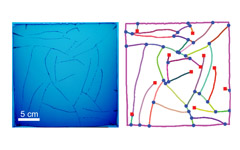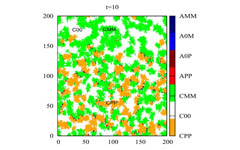Vol. 44 No.5 - Highlights
Dynamic Screening acts on radiating GaAs/AlGaAs quantum wells (Vol. 44 No. 5)
 Dependencies of the THz amplitude on the excitation fluence at different bias voltages. The solid curves are results of calculations by the developed model with the following parameters: me = 0.065m0, mh = 0.5m0, ε = 12.9, α0 = 1.8x104 cm−1 (electron and hole effective masses, dielectric constant and bulk optical absorption coefficient for ħωex = 1.56 eV, respectively). The initial electric field F0 in the QWs was supposed to be equal to the averaged electric field in the structure part containing QWs.
Dependencies of the THz amplitude on the excitation fluence at different bias voltages. The solid curves are results of calculations by the developed model with the following parameters: me = 0.065m0, mh = 0.5m0, ε = 12.9, α0 = 1.8x104 cm−1 (electron and hole effective masses, dielectric constant and bulk optical absorption coefficient for ħωex = 1.56 eV, respectively). The initial electric field F0 in the QWs was supposed to be equal to the averaged electric field in the structure part containing QWs.
The article reports results of investigations of generation of coherent terahertz (THz) radiation from 29 nm thick GaAs/Al0.37Ga0.63As quantum wells (QWs) with transverse electric bias under interband femtoseconds laser photoexcitation at room temperature. The detected THz radiation is attributed to the excitation of time-varying dipole moment induced by polarization of non-equilibrium electron–hole pairs in QWs. Noticeable sub-linearity in the dependence of THz amplitude on excitation density is observed. A theoretical model, which accounts for the dynamic screening of the electric field in wide GaAs QWs by nonequilibrium carriers, has been developed. The model describes well the properties of the observed THz signal.
A.V. Andrianov, P.S. Alekseev, G.V. Klimko, S.V. Ivanov, V.L. Tscheglov, I.V. Sedova, and A.O. Zakhar’in, ‘Influence of dynamic screening effect on coherent terahertz radiation from biased GaAs/AlGaAs quantum wells’, Semicond. Sci. Technol. 28, 105012 (2013)
[Abstract]
Passivated Tunneling Contacts for c-Si Solar Cells by Al2O3 and ZnO Nanolayers (Vol. 44 No. 5)
 Band diagram of the proposed novel front contact
Band diagram of the proposed novel front contact
Al2O3 nanolayers are well-known for their ability to reduce recombination losses at crystalline silicon surfaces, making Al2O3 an attractive material for passivation of the next-generation high efficiency solar cells. In this work, we try to take the application of Al2O3 one step further: when Al2O3 is deposited on n-type silicon, a high concentration of holes accumulates at the surface due to the high density of negative charges in the Al2O3. Consequently a pn-junction is formed which can replace the traditional front side p-doped region made by high temperature diffusion.
The idea presented in the article is to deposit a stack consisting of an Al2O3 and ZnO layer on the silicon. The holes separated from the electrons at the junction can tunnel through the Al2O3 into the transparent conductive ZnO where they are collected with minimal energy loss when the Al2O3 charge density and ZnO doping density are properly tailored. Using atomic layer deposition, it was demonstrated that Al2O3 and Al-doped ZnO films deposited with sub-nanometer precision can be used for this purpose with sufficiently high tunneling currents when the Al2O3 is about 1-2 nm thick.
D. Garcia-Alonso, S. Smit, S. Bordihn and W. M. M. Kessels,
‘Silicon passivation and tunneling contact formation by atomic layer deposited Al2O3/ZnO stacks’, Semicond. Sci. Technol. 28, 082002 (2013)
[Abstract]
Dissecting Deuteron Compton Scattering I (Vol. 44 No. 5)
 Sensitivity of a double-polarisation-asymmetry observable to the E1-M2 spin polarisability.
Sensitivity of a double-polarisation-asymmetry observable to the E1-M2 spin polarisability.
The electromagnetic polarisabilities of the nucleons characterise their responses to external fields. The simplest are the electric and magnetic polarisabilities that describe the induced dipole moments. For spin-1/2 particles there are also four spin polarisabilities, analogous to rotations of the polarisation of light by optically active media. The best experimental window on them is Compton scattering of photons, which has provided good determinations of the electric and magnetic polarisabilities of the proton. Future experiments with polarised protons will give access to its spin polarisabilities. In contrast, much less is known of about the neutron since it does not exist as a stable target. Nonetheless, its properties can be obtained from Compton scattering on light nuclei, most notably the deuteron -- a weakly bound proton and neutron. A new generation of experiments is planned to provide beams of polarised photons on targets of polarised deuterons. If the spins of the final particles are not observed, there are 18 independent observables. This work provides, for the first time, the complete set of these, which will be needed for the experimental analyses. More importantly, it also examines their sensitivities to the various polarisabilities, which will be crucial for the design of the experiments.
H.W. Grießhamme, 'Dissecting Deuteron Compton Scattering I: The Observables with Polarised Initial States', Eur. Phys. J. A, 49, 100 (2013)
[Abstract]
Removing complexity layers from the universe’s creation (Vol. 44 No. 5)
 A schematic depiction of the combined motion that a Brownian particle executes in a background polycrystalline space.
A schematic depiction of the combined motion that a Brownian particle executes in a background polycrystalline space.
Understanding complexity in the early universe may require combining simpler models to interpret cosmological observations. The authors publish results pertaining to theoretical predictions of cosmological systems’ dynamics.
They found that the combination of Einstein’s special relativity and quantum-mechanical dynamics is mathematically identical to a complex dynamical system akin to two interlocked processes with different energy scales. To model it, the authors consider a quantum mechanical dynamics in a background polycrystalline space where particles exhibit a Brownian motion. The observed relativistic dynamics then comes solely from a particular grain distribution in this space. In cosmology, such distribution might stem from early universe’s formation.
This new interpretation focuses on the interaction of a quantum particle with gravity. The non-existence of the relativistic dynamics leads to a natural mechanism for the formation of particles-antiparticles asymmetry. When coupled with cosmology, the authors’ approach predicts that a charge asymmetry should have been produced at ultra-minute fractions of seconds after the Big Bang, in agreement with constraints born out of recent cosmological observations.
P. Jizba and F. Scardigli, ‘Special relativity induced by granular space’, Eur. Phys. J. C 73, 2491 (2013)
[Abstract]
How cells get a skeleton (Vol. 44 No. 5)
 Microscopy image of a cell.
Microscopy image of a cell.
Stress generated by nano-motors within animal cells can lead to the creation of a condensed layer of filaments beneath the outer cell membrane.
The authors have found that a well-defined layer beneath animal cells’ outer membrane forms beyond a certain critical level of stress generated by motor proteins within the cellular system. They have created hydrodynamic models of active gels to model the cell cortex. They first derived the equations providing a coarse-grained description of cortical dynamics, then calculated the configuration in which their model was in a steady state.
They found that for sufficiently high levels of contractile stress it consisted of a dense layer near the membrane, which abruptly cut off beyond a certain thickness. The key advance in their model is the inclusion of gel disassembly throughout the system, and the contractility due to molecular motors.
J.-F. Joanny, K. Kruse, J. Prost and S. Ramaswamy, ‘The actin cortex as an active wetting layer’, Eur. Phys. J. E 36, 52 (2013)
[Abstract]
Novel beams made of twisted atoms (Vol. 44 No. 5)
 'Snapshot' of atomic Bessel beam profiles.
'Snapshot' of atomic Bessel beam profiles.
Scientists can now theoretically construct atomic beams of a particular kind, which may apply in fields like quantum communication.
The present paper presents a theoretical construct of beams made of twisted atoms. These so-called atomic Bessel beams can, in principle, have potential applications in quantum communication as well as in atomic and nuclear processes.
The authors focused on a beam made of twisted two-level atoms, which are driven by a laser field. They created a theoretical construct by using an equation, referred to as the non-relativistic Schrödinger equation, for atoms which are moving much slower than the speed of light. The authors solved this equation by taking into account the propagation directions of both the atomic and laser beams. By superimposing a multitude of plane waves with well-defined amplitudes, they produced Bessel beams for two-level atoms that resonantly interact with the laser field.
A.G. Hayrapetyan, O. Matula, A. Surzhykov and S. Fritzsche, 'Bessel beams of two-level atoms driven by a linearly polarized laser field', Eur. Phys. J. D, 67, 167 (2013)
[Abstract]
Analysis of the charge state distribution in Ar plasma (Vol. 44 No. 5)
 Double crystal X-ray spectrum showing Ar12+ to Ar14+ transitions.
Double crystal X-ray spectrum showing Ar12+ to Ar14+ transitions.
Investigation of charge state distributions (CSD) in astrophysical as well as laboratory plasmas, such as those provided by electron-beam ion traps, electron– cyclotron-resonance ion source (ECRIS) and tokamaks, is very important for the understanding of plasma processes. This knowledge is crucial for the optimization of a given ion source so that higher yields of higher charge states can be obtained. Furthermore, characterization of the CSD enables precise diagnostics of injected elements and impurities, which are important for the performance of fusion devices.
In this work, we have determined the CSD of an Ar plasma through the analysis of x-ray spectra obtained with a double crystal spectrometer. It is the first time that such a spectrometer is used coupled to an ECRIS for measuring inner-shell transitions in highly charged ions. The very high resolution of this apparatus enables us to correctly obtain the CSD of the plasma from x-ray spectra, even in highly populated energy regions.
Comparison to extracted ion currents show that the CSD in the center of the plasma can be quite different from the ion beam yields, due to the fact that the ions are extracted from the plasma edges.
M. Guerra, P. Amaro, C.I. Szabo, A. Gumberidze, P. Indelicato and J.P. Santos,
'Analysis of the charge state distribution in an ECRIS Ar plasma using high-resolution x-ray spectra', J. Phys. B: At. Mol. Opt. Phys. 46, 065701 (2013)
[Abstract]
Optical waveguide arrays (Vol. 44 No. 5)
 Centre or edge localization in tunable waveguide arrays.
Centre or edge localization in tunable waveguide arrays.
Over the past few years, advances in fabrication have made possible arrangements of coupled optical waveguides with tailored specifications. Such waveguide arrays are indispensible for building a scalable photonic quantum computer or creating novel optical elements.
The present paper summarizes the properties of light propagation in such an array with position-dependent coupling between adjacent waveguides. It shows that such arrays have properties that are markedly different from those of constant-coupling arrays. One such property is the formation of mirror-symmetric intensity profile in an array with a centre-maximum coupling profile. Another, shown in the figure, is the disorder-induced localization of a broad-input light to the centre of the array for centre-maximum coupling profiles and to the array edges, which occurs for centre-minimum coupling profiles.
These results, along with novel properties of light propagation in the presence of balanced, spatially separated absorption and amplification, indicate the wealth of tunability that is offered by coupled optical waveguides.
Y. N. Joglekar, C. Thompson, D. D. Scott and G. Vemuri
, ‘Optical waveguide arrays: quantum effects and PT symmetry breaking’, Eur. Phys. J. AP
[Abstract]
Topology of fluid drainage fracture networks (Vol. 44 No. 5)
 Drainage fractures in gelatine layer. Blue circles – nodes, red squares – dead ends.
Drainage fractures in gelatine layer. Blue circles – nodes, red squares – dead ends.
Fluid generation in rocks is a common phenomenon: generation of hydrocarbons (oil\gas) from source rocks during diagenesis, dehydration of sedimentary and metamorphic rocks during burial and partial melting of the Earth’s mantle. Fluid generation leads to local increase in fluid pressure. If the rate of fluid production is high compared to the rate at which fluids can escape by flow through the initial permeability, the fluid pressure increases and may cause fracturing and creation of new fluid transport pathways.
This paper presents the development of fracture networks in a simple quasi-2D system consisting of a confined layer of gelatine containing yeast that consumes sugar to produce CO2. The topological properties of the emerging fracture networks were found to be intermediate between the tree-like structure of river networks and the fragmentation cracking patterns observed in drying muds, domain splitting during rock weathering and fracturing of cooling basalts. The ratio of the number of dead ends to the amount of nodes is ~0.4, between the ratio for rivers (=1) and fragmentation crack patterns (=0). Understanding of fluid drainage network topology is crucial for uncovering the mechanisms which lead to its formation.
M. Kobchenko, A. Hafver, E. Jettestuen, O. Galland, F. Renard, P. Meakin, B. Jamtveit and D. K. Dysthe, ‘Drainage fracture networks in elastic solids with internal fluid generation’, EPL, 102, 66002 (2013)
[Abstract]
A meta-diffraction-grating for visible light (Vol. 44 No. 5)
 Intensities diffracted into first diffraction order. Inset: SEM image of the planar meta-grating mimicking a bulk blazed grating profile.
Intensities diffracted into first diffraction order. Inset: SEM image of the planar meta-grating mimicking a bulk blazed grating profile.
Metamaterials — artificially engineered structures with building blocks smaller than the wavelength of light — have delivered a new way to design and make materials with exotic electromagnetic properties. The current challenge is to make these metamaterials into meta-devices that convert the promising research into practical applications. Nanotechnology has made it possible to fabricate ultrathin metamaterials – less than a 15th of the wavelength – shrinking conventional optical devices into planar form. In the coming years, research in metamaterials, plasmonics and nanofabrication will revolutionize device form and function throughout the electromagnetic spectrum.
This paper reports experimental demonstration of a planar ultrathin (50 nm) gold diffraction grating, mimicking the function of a bulk dielectric grating but tens of times thinner. It uses the resonant properties of individual sub-wavelength meta-atoms to change the phase of the light passing through it, in the same way as a blazed diffraction grating. It functions throughout the visible region of the spectrum (400 – 900 nm), with peak efficiency at 736 nm, and exhibits asymmetric diffraction, sending 25 times more light to the left than the right.
T. Roy, A.E. Nikolaenko and E.T.F. Rogers, ‘A meta-diffraction-grating for visible light’, J. Opt. 15, 085101 (2013)
[Abstract]
When diffusion depends on chronology (Vol. 44 No. 5)
 Motorways are examples of nodes connected by edges studied as complex networks. (Photo Credit: Highways Agency)
Motorways are examples of nodes connected by edges studied as complex networks. (Photo Credit: Highways Agency)
The present work shows that the order of events taking place in complex networks may dramatically alter the way diffusion occurs in them. The Internet, motorways and other transport systems as well as many social and biological systems are composed of nodes connected by edges, and can be represented as networks.
Scientists studying diffusion over such networks over time have now identified the temporal characteristics that affect their diffusion pathways. In this paper, the authors show that one key factor that can dramatically change a diffusion process is the order in which events take place in complex networks.
They developed an analytical model to better understand the properties of time-dependent networks that either accelerate or slow down diffusion. Their study focused on different classes of popular models for diffusion, namely random walks and epidemic spread models, and found the way in which the temporal ordering of events matters. They expect these results to help in building more appropriate metrics to understand real-world complex network data.
R. Lambiotte, L. Tabourier and J.C. Delvenne, ‘Burstiness and spreading on temporal networks’, Eur. Phys. J. B (2013)
[Abstract]
Studying emotions causing opinions to change (Vol. 44 No. 5)
 Example of evolution of agent opinions.
Example of evolution of agent opinions.
Physicists can use their tools to help understand how, in real life, opinions form and change by modelling the complex interactions between information and emotion. Social phenomena fascinate with their complexity, but are not easily understood. The author of the present article has developed a model to study the dynamic of ‘agents’ and their response to a given piece of information, depending on their emotional state. He shows that opinion dynamics differ depending on whether the agent is agitated or not.
The premise for this study was to consider that a given agent opinion about a particular issue is determined by both its information about the issue and its subsequent emotional response. The author assumes the possibility of the same information leading to different opinions when agents are agitated. This results in an individual opinion dynamics.
The author’s findings, relevant to a simplified social environment, are directly comparable with social observations. These include the stability of minority groups surrounded by enemies and the fact that so many elections have results close to the 50/50 ratio.
P. Sobkowicz, ‘Minority persistence in agent based model using information and emotional arousal as control variables’, Eur. Phys. J. B, (2013)
[Abstract]





